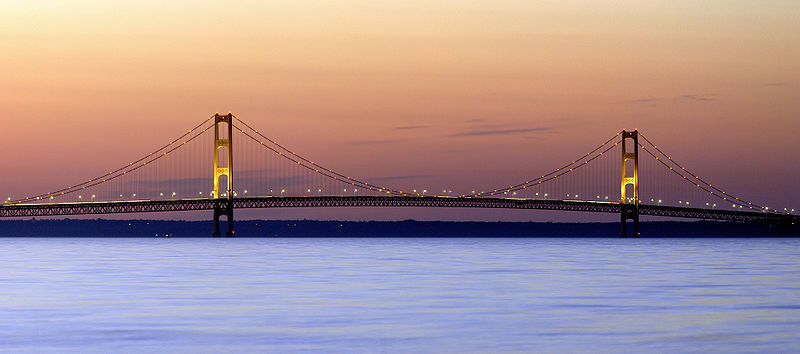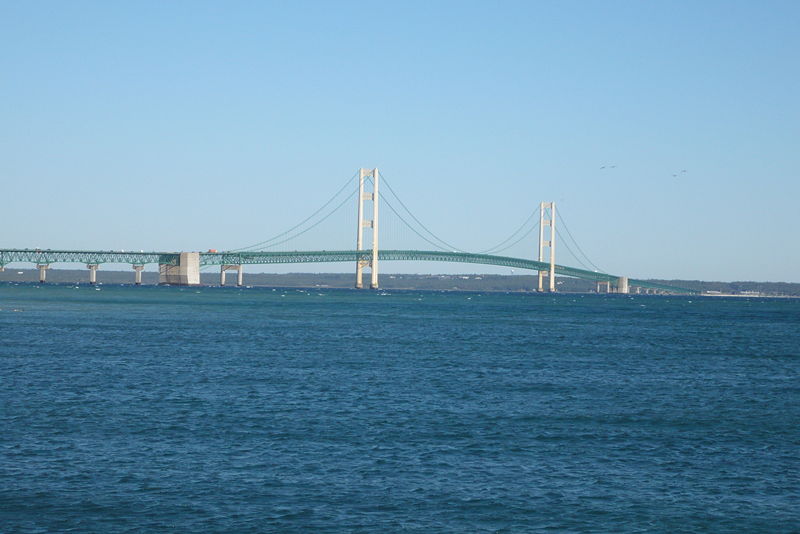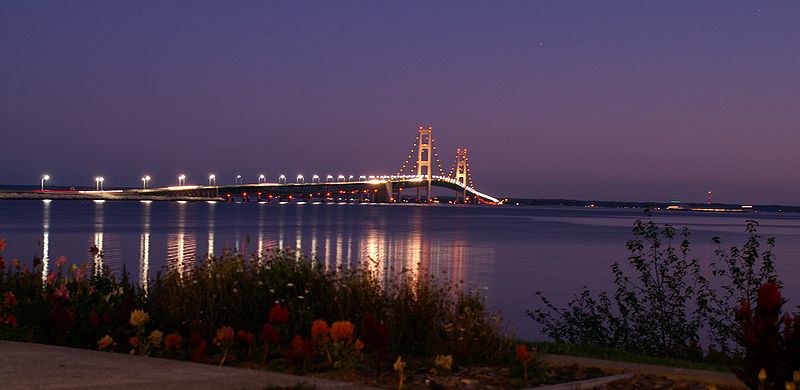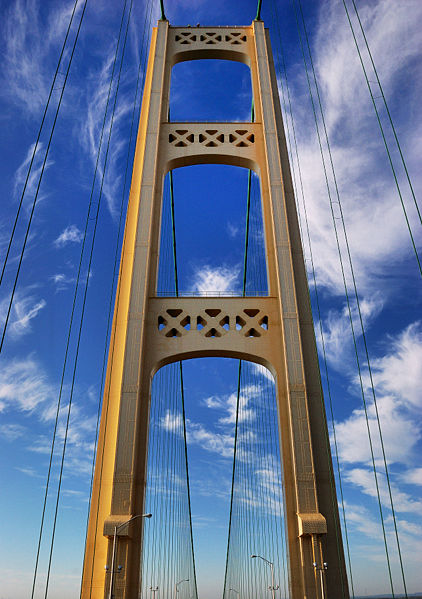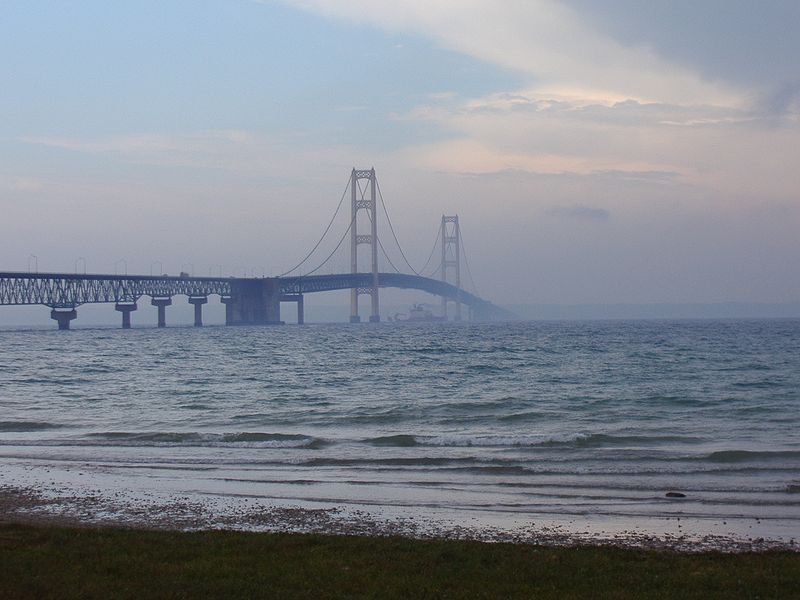| |||||||
Europe
North AmericaSouth AmericaAsiaAustralia and OceaniaAfrica |
Смотрите также: Mackinac Bridge The Mackinac Bridge is a suspension bridge spanning the Straits of Mackinac to connect the non-contiguous Upper and Lower peninsulas of the U.S. state of Michigan. Envisioned since the 1880s, the bridge was completed only after many decades of struggles to begin construction. Designed by engineer David B. Steinman, the bridge (familiarly known as "Big Mac" and "Mighty Mac") connects the city of St. Ignace on the north end with the village of Mackinaw City on the south. It is the longest suspension bridge between anchorages in the Western hemisphere.
Mackinac Bridge Carries 4 lanes of Interstate 75 Crosses Straits of Mackinac Locale Mackinaw City and St. Ignace, Michigan Design Suspension bridge Longest span 3,800 feet (1,158 m) Total length 26,372 feet (8,038 m) Width 68.6 feet (20.9 m) (total width) 54 feet (16 m) (road width) 38.1 feet (11.6 m) (depth) Height 522 feet (159 m) Vertical clearance 200 feet (61 m) Clearance below 155 feet (47 m) Opening date November 1, 1957 Length The bridge opened on November 1, 1957, ending decades of the two peninsulas being solely linked by ferries. A year later, the bridge was formally dedicated as "the world's longest suspension bridge between anchorages". This designation was chosen because the bridge would not be the world's largest using another way of measuring suspension bridges, the length of the center span between the towers; at the time that title belonged to the Golden Gate Bridge, which has a longer center span. By saying "between anchorages", the bridge could be considered longer than the Golden Gate Bridge and also longer than the suspended western section of the San Francisco – Oakland Bay Bridge. (That bridge has a longer total suspension but is a double bridge with an anchorage in the middle.)
At 8,614 feet (2,626 m), the Mackinac Bridge is the longest suspension bridge with two towers between anchorages in the Western Hemisphere. Much longer anchorage-to-anchorage spans have been built in the Eastern Hemisphere, including the Akashi-Kaikyo Bridge in Japan (12,826 feet (3,909 m)). However, because of the long leadups to the anchorages on the Mackinac, from shoreline to shoreline it is much longer at 5 miles (8.0 km) than the Akashi-Kaikyo (2.4 miles (3.9 km)). The length of the bridge's main span is 3,800 feet (1,158 m), which makes it the third-longest suspension span in the United States and twelfth longest worldwide.
History The Algonquin Native Americans called the straits and the surrounding area "Michilimackinac", meaning "the jumping-off place" or "great road of departure". These Native Americans moved around the straits rather than crossing them. The straits were the end of the trail. As Europeans settled in the area, the straits became an important area for trade and commerce. The clean air, abundant fish, and beautiful views attracted people from all over the area to the straits. Still, the only way to cross was by ferry. Typically, a fleet of nine ferries could carry as many as 9,000 vehicles per day. Traffic backups sometimes stretched 16 miles (26 km) to Cheboygan, Michigan. Year-round boat service across the straits had been abandoned as impractical because of the cold winters that would often freeze the water across the entire strait. After the opening of the Brooklyn Bridge in 1883, local residents began to imagine that such a structure could span the straits. In 1884, a store owner in St. Ignace published a newspaper advertisement that included a reprint of an artist's conception of the Brooklyn Bridge with the caption "Proposed bridge across the Straits of Mackinac". The idea of the bridge was discussed in the Michigan Legislature as early as the 1880s. At the time, the area was becoming a popular tourist destination, including the creation of Mackinac National Park on Mackinac Island in 1875. Despite the perceived necessity for the bridge, several decades elapsed with no formal plan. In 1920, the Michigan state highway commissioner advocated the construction of a floating tunnel across the straits. At the invitation of the state legislature, C. E. Fowler of New York City put forth a plan for a long series of causeways and bridges across the straits from Cheboygan, 17 miles (27 km) southeast of Mackinaw City, to St. Ignace, using Bois Blanc, Round, and Mackinac Island as intermediate steps. In 1923, the state legislature ordered the State Highway Department to establish ferry service across the strait. More and more people used ferries to cross the straits each year, and as they did, momentum to create a bridge grew even stronger. Chase Osborn, a former governor, wrote, "Michigan is unifying itself, and a magnificent new route through Michigan to Lake Superior and the Northwest United States is developing, via the Straits of Mackinac. It cannot continue to grow as it ought with clumsy and inadequate ferries for any portion of the year." By 1928, the ferry service had become so popular and so expensive to operate that Michigan Governor Fred Green ordered the department to study the feasibility of building a bridge across the strait. The department deemed the idea feasible, estimating the cost at $30 million. In 1934, the Michigan Legislature created the Mackinac Straits Bridge Authority to explore possible methods of constructing and funding the proposed bridge. The Legislature authorized the Authority to seek financing for the project. In the mid 1930s, the Authority twice attempted to obtain federal funds for the project but was unsuccessful, despite the endorsement of the United States Army Corps of Engineers and President Franklin D. Roosevelt. Nevertheless, between 1936 and 1940, a route was selected for the bridge, and borings were made for a detailed geological study of the route. The preliminary plans for the bridge featured a 3-lane roadway, a railroad crossing on the underdeck of the span, and a center-anchorage double-suspension bridge configuration similar to the design of the San Francisco – Oakland Bay Bridge. Because this would have required sinking an anchorage pier in the deepest area of the Straits, the practicality of this design may have been questionable. A concrete causeway, approximately 4,000 feet (1,219 m), extending from the northern shore, was constructed in shallow water from 1939 to 1941. At that time, with funding for the project still uncertain, further work was put on hold because of World War II. The Mackinac Straits Bridge Authority was abolished by the state legislature in 1947, but the same body created a new Mackinac Bridge Authority three years later in 1950. In June 1950, engineers were retained for the project. After a report by the engineers in January 1951, the state legistature authorized the sale of $85 million in bonds for bridge construction on April 30, 1952. However, a weak bond market in 1953 forced a delay of more than a year before the bonds could be issued. G. Mennen Williams was governor during the construction of the Mackinac Bridge. He began the tradition of the governor leading the Mackinac Bridge Walk across it every Labor Day. Engineering and construction David B. Steinman was appointed as the design engineer in January 1953. By the end of 1953, estimates and contracts had been negotiated, and construction began on May 7, 1954. The American Bridge Division of United States Steel Corporation was awarded a contract of more than $44 million to build the steel superstructure.
Construction, which utilized the 1939-41 causeway, took three and a half years (four summers, no winter construction) at a total cost of 100 million dollars and the lives of five men who worked on the bridge. It opened to traffic on schedule on November 1, 1957, and was formally dedicated on June 25, 1958. The bridge officially achieved its 100 millionth crossing exactly forty years after its dedication, on June 25, 1998. The 50th anniversary of the bridge's opening was celebrated in a ceremony hosted by the Mackinac Bridge Authority at the viewing park adjacent to the St. Ignace causeway on November 1, 2007.
History of bridge design The design of the Mackinac Bridge was directly influenced by the lessons of the first Tacoma Narrows Bridge, which failed in 1940 because of its instability in high winds. Three years after that disaster, Steinman had published a theoretical analysis of suspension-bridge stability problems, which recommended that future bridge designs include deep stiffening trusses to support the bridge deck and an open-grid roadway to reduce its wind resistance. Both of these features were incorporated into the Mackinac Bridge. The stiffening truss is open to reduce wind resistance. The road deck is shaped as an airfoil to provide lift in a cross wind, and the center two lanes are open grid to allow vertical (upward) air flow, which fairly precisely cancels the lift, making the roadway stable in design in winds up to 150 miles per hour (240 km/h). Comments: 0 |
|
|||||







































